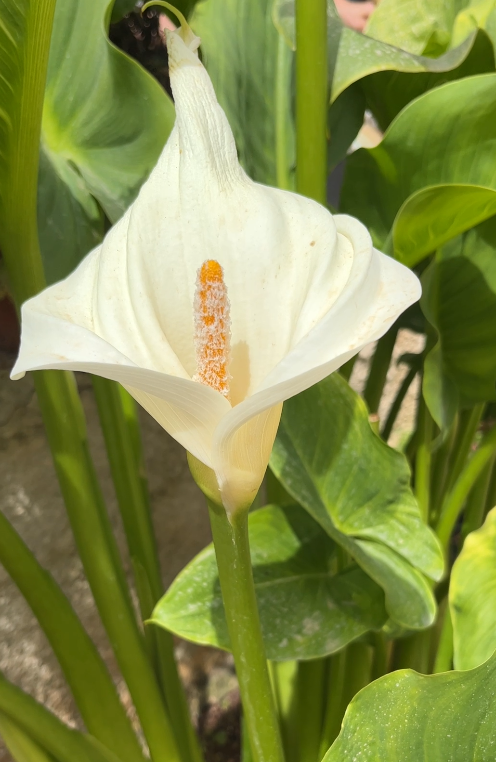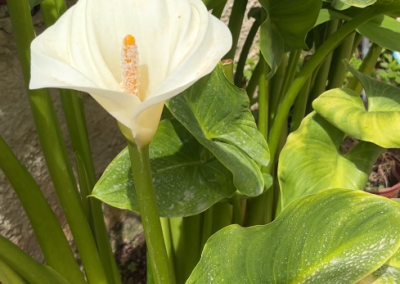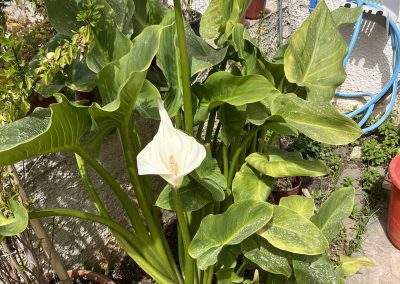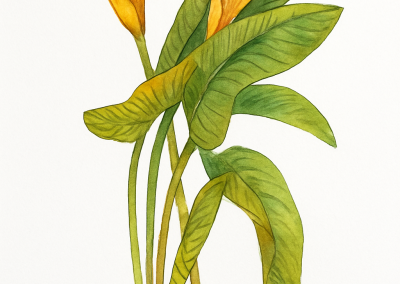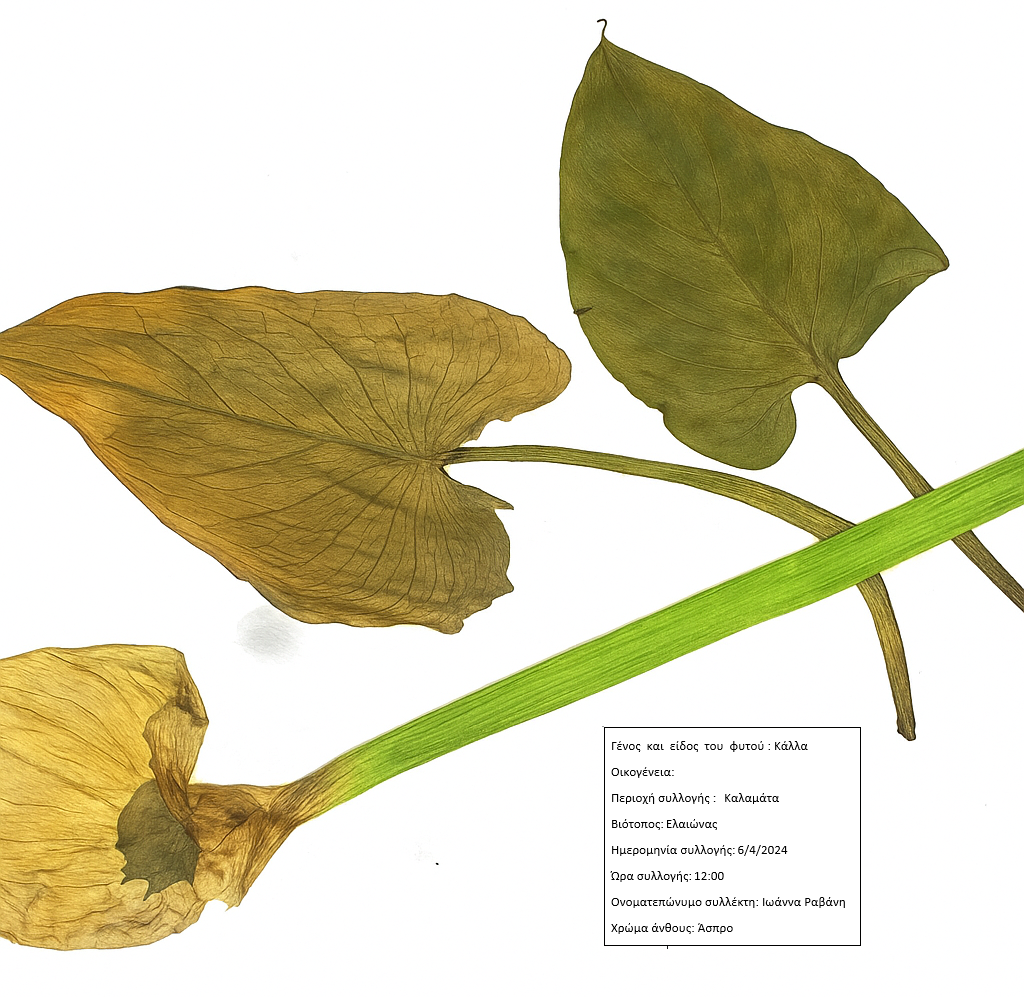Zantedeschia aethiopica
Scientific description
Scientific name: Zantedeschia aethiopica
Common name: Calla aethiopica
Kingdom: Plantae
Clade: Tracheophytes, Angiosperms, Monocots
Series: Alystemata
Family: Araceae
Genus: Zandeneskia
Species: Zantedeschia aethiopica
Origin: South Africa
Ecology: Grows in wet, often riparian or swampy habitats.
Description:
Perennial, herbaceous geophyte. Terrestrial parts arise from buds on a tuberous, fleshy rootstock. Robust, lush growth 0.6–1 m high, 30–60 cm wide, forming dense clusters of large, lanceolate, bright green, glossy leaves on strong, upright cylindrical stems. Flowers from March to June; showy, fragrant spathes, golden-yellow spadices wrapped in large, pure white bracts.
Propagation: Mainly by division of the rhizome.
Uses: Popular ornamental calla; parent of modern hybrids. Suitable for riparian/lakeside plantings, mixed perennial flowerbeds, borders, and large planters. Parts are reportedly consumed in South Africa after processing, but the plant is toxic due to calcium oxalate crystals.
Zantedeschia aethiopica (Κάλλα η αιθιοπική)
Βασίλειο: Plantae
Κλάδος: Τραχειόφυτα, Αγγειόσπερμα, Μονοκοτυλήδονα
Τάξη: Αλισματάλες
Οικογένεια: Araceae
Γένος: Ζαντεντέσκια
Είδος: Zantedeschia aethiopica
Γνωστό και ως: Calla aethiopica
Καταγωγή: Νότια Αφρική
Οικολογία: Φύεται σε υγρές, συχνά παρόχθιες ή βαλτώδεις περιοχές.
Περιγραφή:
Πολυετές, ποώδες είδος. Όλα τα επίγεια μέρη εκφύονται από οφθαλμούς στο κονδυλώδες, σαρκώδες ρίζωμά του. Εύρωστη ανάπτυξη 0,6–1 m ύψος, 30–60 cm πλάτος, σχηματίζει πυκνές συστάδες πολύ μεγάλων λογχοειδών, γυαλιστερών φύλλων σε ισχυρά, όρθια στελέχη κυλινδρικής διατομής. Ανθοφορία Μάρτιος–Ιούνιος, με εντυπωσιακές, αρωματικές σπάθες: χρυσοκίτρινοι σπάδικες με μεγάλο λευκό βράκτιο.
Πολλαπλασιασμός: Κυρίως με διαίρεση του ριζώματος.
Χρήσεις: Δημοφιλές διακοσμητικό, υβριδικές ποικιλίες, κατάλληλο για παρόχθιες/παραλίμνιες φυτεύσεις, παρτέρια, μπορντούρες, μεγάλα φυτοδοχεία. Το φυτό είναι τοξικό λόγω κρυστάλλων οξαλικού ασβεστίου.
Zantedeschia aethiopica (Arum blanc)
Règne: Plantae
Clade: Trachéophytes, Angiospermes, Monocotylédones
Série: Alystemata
Famille: Aracées
Genre: Zandeneskia
Espèce: Zantedeschia aethiopica
Également connu sous le nom de: Arum d'Éthiopie
Origine: Afrique du Sud
Écologie: Milieux humides, souvent riverains ou marécageux.
Description:
Plante herbacée vivace. Parties terrestres issues de bourgeons sur rhizome tubéreux et charnu. Végétation robuste 0,6–1 m de haut, 30–60 cm de large, formant des grappes de grandes feuilles lancéolées, vert vif, brillantes sur tiges dressées cylindriques. Floraison mars–juin, spathes spectaculaires et parfumées, spadices jaune doré enveloppés d’une grande bractée blanche.
Propagation: Par division du rhizome.
Utilisations: Espèce ornementale populaire, parent de variétés hybrides modernes. Plantations riveraines/lacs, massifs, bordures, pots. Plante entière toxique à cause des cristaux d’oxalate de calcium.
Zantedeschia aethiopica
Sinonim: Calla aethiopica
Denumire comună: Cala albă, Crin de baltă
Regn: Plantae
Cladă: Tracheophytes, Angiosperme, Monocotiledonate
Seria: Alystemata
Familie: Araceae
Gen: Zantedeschia
Specie: Zantedeschia aethiopica
Origine: Africa de Sud
Ecologie: Habitate umede, adesea ripariene sau mlaștinoase.
Descriere:
Plantă perenă, erbacee, geofit. Părțile aeriene provin din muguri pe rizom tuberos, cărnos. Creștere viguroasă 0,6–1 m înălțime, 30–60 cm lățime, formând mănunchiuri de frunze mari, lanceolate, lucioase, verde intens, pe tulpini verticale cilindrice. Florare martie–iunie, spadice galben-auriu învelite de bractee albe pur.
Înmulțire: Prin divizarea rizomului.
Utilizări: Populară pentru hibridizare, creștere viguroasă și flori albe mari. Plantări pe maluri, grădini ornamentale, ronduri, ghivece mari. Plante toxică din cauza cristalelor de oxalat de calciu.
Creative writing inspired by Zantedeschia aethiopica
Zantedeschia aethiopica — Calla Lily
In the depths of ancient times, the goddess Hera, wife of Zeus and protector of marriage, had a garden filled with the most beautiful and rare flowers. Yet, none of them were as striking as a flower that had not yet existed: the Calla Lily.
One day, Hera decided to create a flower so beautiful and pure that it would represent innocence and purity. From her hands, the Calla Lily was born, its white, delicate petals resembling the gentle embrace of a goddess, wrapping around its golden center. The brilliant white form symbolized innocence and purity, while the golden heart represented the light of truth.
However, Zeus, known for his many adventures, saw the beauty of the Calla Lily and grew envious that Hera had created such a magnificent flower. He attempted to take the flower and plant it in his own gardens. Enraged by his actions, Hera gave the Calla Lily the ability to grow in difficult soils, far from the reach of the gods.
From that time onward, the Calla Lily became a symbol of protection and resilience. Wherever it grows, it flourishes with unique beauty, even in the harshest environments, reminding all of the power of purity and the protection of the goddess Hera.


